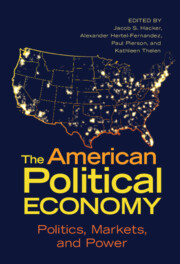Book contents
- The American Political Economy
- The American Political Economy
- Copyright page
- Contents
- Figures
- Tables
- Contributors
- Acknowledgments
- Introduction The American Political Economy: A Framework and Agenda for Research
- I Political Arenas and Actors
- II Race, Space, and Governance
- 4 Racial Inequality, Market Inequality, and the American Political Economy
- 5 The Production of Local Inequality: Race, Class, and Land Use in American Cities
- 6 The City Re-centered? Local Inequality Mitigation in the 21st Century
- 7 The Political Economies of Red States
- III Corporate Power and Concentration
- IV The American Knowledge Economy
- Bibliography
6 - The City Re-centered? Local Inequality Mitigation in the 21st Century
from II - Race, Space, and Governance
Published online by Cambridge University Press: 29 October 2021
- The American Political Economy
- The American Political Economy
- Copyright page
- Contents
- Figures
- Tables
- Contributors
- Acknowledgments
- Introduction The American Political Economy: A Framework and Agenda for Research
- I Political Arenas and Actors
- II Race, Space, and Governance
- 4 Racial Inequality, Market Inequality, and the American Political Economy
- 5 The Production of Local Inequality: Race, Class, and Land Use in American Cities
- 6 The City Re-centered? Local Inequality Mitigation in the 21st Century
- 7 The Political Economies of Red States
- III Corporate Power and Concentration
- IV The American Knowledge Economy
- Bibliography
Summary
In the winter of 2019, four surprising pieces of news emerged from New York City in quick succession. First, in mid-January, Mayor Bill de Blasio announced a new program that would provide free healthcare to undocumented immigrants and other uninsured New Yorkers, at an expected cost of $100 million (Goodman 2019b). Across the river in Queens a month later, local activists protested and ultimately defeated the arrival of the Amazon HQ2 corporate campus, which would have employed tens of thousands and generated millions in revenues for city and state coffers (Goodman 2019a). Each of these outcomes runs contrary to long-held beliefs about how we expect American cities to govern themselves in an era of inequality, mobile wealth, and porous municipal borders: public and private elites partner to court outside investment as a top priority, override grassroots protests, and avoid redistributive programs that might push the wealthy out and draw the poor in.
- Type
- Chapter
- Information
- The American Political EconomyPolitics, Markets, and Power, pp. 181 - 208Publisher: Cambridge University PressPrint publication year: 2021
- 3
- Cited by



